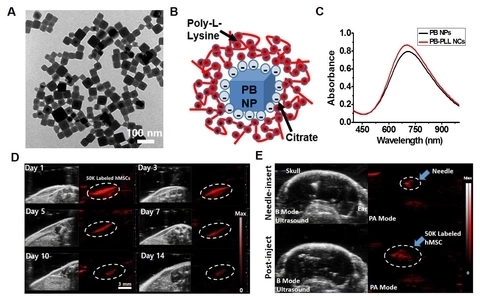
Submitted by: Dr. Taeho Kim, University of California, San Diego, USA.
Stem cell imaging is indispensable for monitoring and supporting regenerative medicine. MR imaging has long been the gold standard for stem cell tracking due to its excellent spatial resolution and soft tissue contrast. However, MRI has relatively poor temporal resolution of minutes, which prevents its widespread utility in imaging of cell implantation. While micro-CT imaging has good temporal resolution, it also has limited sensitivity and poor soft tissue contrast, which hampers its broad use in stem cell tracking applications. Photoacoustic imaging can overcome these limitations as a powerful tool with excellent spatial (50-150 μm) and temporal resolution (100 ms). Photoacoustic imaging can also be coupled with B-mode ultrasound for anatomical information in real time during cell transplantation events. In this study, we developed a simple and efficient method for sensitive photoacoustic stem cell imaging using Prussian blue nanoparticles (PBNPs).
We synthesized PBNPs (size of 50-60 nm; Figure A) by the reaction of FeCl3 with K4[Fe(CN)6] in the presence of citric acid, and complexed with the cationic transfection agent poly-L-lysine (PLL) (Figure B). These PLL coated PBNPs (PB-PLL nanocomplexes) have a maximum absorption peak at 715 nm (Figure C) and could efficiently label human mesenchymal stem cells (hMSCs).
When PB-labeled cells were imaged with Vevo-LAZR scanner with pulsed laser excitation at 730 nm, they exhibited very strong photoacoustic contrast with the detection limit of 200 cells/μL in vivo. The long term visualization of the engrafted hMSCs (as low as 50 × 10^3 cells) was allowed for two weeks in living animals (Figure D).
Additionally, in hybrid ultrasound/photoacoustic imaging of Vevo-LAZR system, this approach offered real-time and image-guided cellular injection through intact skull into the mouse brain (Figure E). We believe Vevo-LAZR is perfect for cell tracking studies and photoacoustic imaging technique with PBNPs is an effective tool for monitoring stem cell therapy.